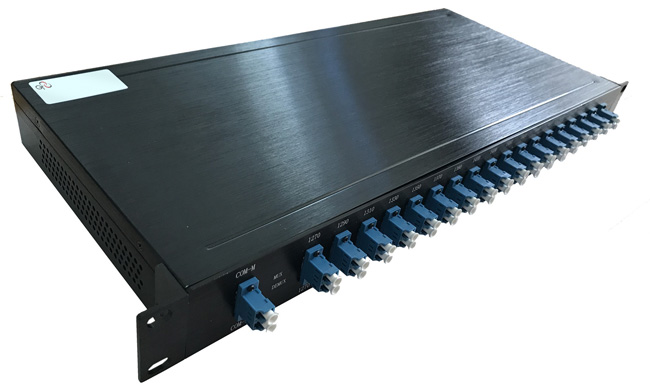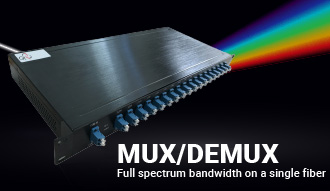CWDM & DWDM MUX/DEMUX CUSTOMIZABLE OPTIONS
GigaTech Products offers customizable Multiplexer / Demultiplexer solutions designed to maximize your network connectivity while saving on the cost and energy of running multiple fiber installations. Whether it be small targeted wavelengths to upwards of 44 specific channels, CWDM (Course Wavelength Division Multiplexing) and DWDM (Dense Wavelength Division Multiplexing) Mux/Demux solutions create a more efficient and cost effective fiber network. By pairing these devices, multiple channels can be utilized over a single duplex fiber cable between locations.
- Ports can be customized in quantity and wavelengths required
- Cost efficient in saving fiber run between facilities while maximizing total number of channels and bandwidth used
- Passive components require no power consumption
- Available options for monitoring and expansion ports for future proofing

Monitor Port: This port monitors a low-power sample of the optical signal occurring on the common port, this is usually at 5% or less power level. This can be simplex or duplex.
Upgrade (Expansion) Port: This port is used to add or expand more wavelengths to the network. This means when a Mux/DeMux cannot meet all wavelength requirements, an expansion port can be used to add these additional wavelengths.
1310nm Port: This port is used to combine an existing 1310nm network connection with the CWDM or DWDM over the same common line. When using 1310nm Port, CWDM wavelengths 1290, 1310 and 1330 should not be used as Channel Ports
1550nm Port: This port is used to combine an existing 1550nm network connection with the CWDM or DWDM over the same common line. When using 1550nm Port, CWDM wavelengths 1530, 1550 and 1570 should not be used as Channel Ports
Benefits of utilizing a Mux/Demux
WDM technology allows for the bidirectionalBi-Directional (BiDi) Transceiver is a compact optical transceiver module that uses WDM (wavelength division multiplexing) technology . Bi-Directional technology means a communication mode that processes data in both directions. Click to Read More transmission of multiple data streams at different frequencies over a single optical fiber. While utilizing less cabling, Mux/Demux allows for an increase in bandwidth with a reduced network footprint, and its inherent passive architecture translates to lower power consumption. Implementation of Mux/Demux provides an attractive solution for those wanting to expand their network for increased traffic needs while minimizing additional fiber cable deployment.
CWDM vs DWDM: Choosing the best solution for your network environment
Coarse Wavelength Division Multiplexing (CWDM) and Dense Wavelength Division Multiplexing (DWDM) are the two key WDM technologies to choose from. Which solution is best suited to a network environment depends on user requirements.
| CWDM | DWDM |
| Maximum of 18 wavelengths over one pair of fiber | Maximum of 160 channels over one pair of fiber (25GHz Channel Spacing) |
| Defined by wavelengths (1270-1610nm) | Defined by frequencies and wavelength (channels) w/1525-1565nm (C Band) being most common |
| Wavelengths spread far apart W/ 20nm spacing | Wavelengths are tightly packed W/ 0.8nm separation (100GHz C-Band) |
| No amplification required | Amplification is not required, but may be used to increase distances |
| 80km Max distance | 70km Max Distance non-Amplified, 1000km+ using Amplification |
| Speeds up to 16G Fiber Channel | All Speeds ranges including 100G and Beyond |
